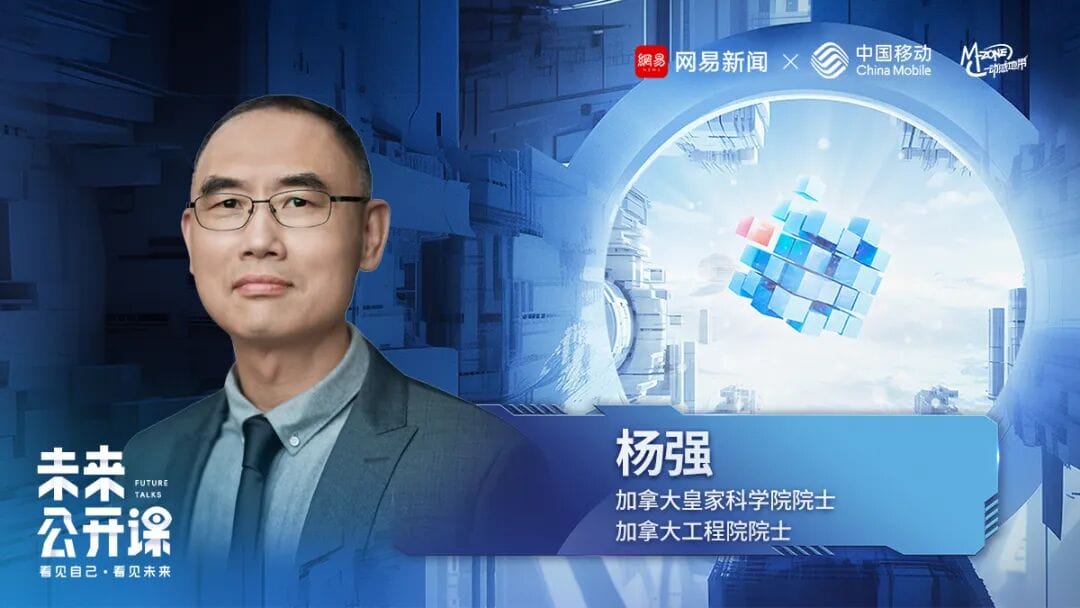Dialogue with Academician Yang Qiang: When AGI Truly Arrives, Humans and AI Will Coexist Harmoniously

Academician Qiang Yang: When True AGI Arrives, We Won’t Be Able to Tell Robots from Humans


The 2025 NetEase Future Open Class gathered leading experts, entrepreneurs, investors, and economists to explore the cutting edge of artificial intelligence — from breakthroughs in large model technology and industry adoption, to embodied intelligence, the robotics revolution, and AI entrepreneurship and investment.
The discussions focused on how AI will deeply connect the present reality with the future.
On September 27, the Future Open Class hosted an exclusive interview with Qiang Yang — Academician of the Canadian Academy of Engineering and the Royal Society of Canada, and Director of the Hong Kong Polytechnic University’s Institute of Artificial Intelligence — to delve into AI applications and the journey toward AGI.

Yang stressed that when AGI truly arrives, it may become impossible to distinguish robots from humans. More importantly, humans and AI will coexist harmoniously — without threat or suspicion.
However, technical innovation remains critical. Large models are still in their infancy and far from ideal, working mainly as single-purpose agents capable of simple responses. There is still a significant gap before reaching true AGI.
---
Highlights from the Exclusive Interview
China’s AI Development Stage
Q: At what stage is China’s AI development right now?
Yang:
- Globally, China and the U.S. are the leaders in AI research.
- Both are in a preliminary exploration phase — tech is evolving fast, but application growth lags behind.
- China's strength: Building leading consumer-facing applications in e-commerce, short video, and recommendation systems.
- Business-facing AI (to-B) is on par with the U.S., though the U.S. has wider deployments.
- Next focus: Technological innovation in large models and AI systems.
---
Timeline for AGI
Q: When will AGI arrive?
Yang:
- AGI’s arrival depends on three prerequisites:
- Abundant, high-quality data
- Robust computing infrastructure
- Algorithms are less of a barrier than the above two.
- With AGI, collaboration will flourish, making work and life more engaging and meaningful.
---
Boundaries of AI
Q: Where are AI’s boundaries? Are there red lines?
Yang:
- AI will surpass humans in certain vertical domains (e.g., chess, Go).
- In general capabilities and emotional intelligence, humans are still more versatile.
- AI will lead in some areas, lag behind in others, and match humans in a few.
---
Federated Learning Explained
Q: For those unfamiliar, what is federated learning?
Yang:
- In the 1990s, computing worked on single machines.
- The internet connected machines, enabling shared knowledge.
- Today’s AI is still centrally trained — single models, isolated.
- Next step: Networked models sharing strengths without exposing sensitive data.
Analogy: A group of students can learn from each other’s answers without showing the original homework.
---
Industries Benefiting from Federated / Transfer Learning
Yang:
- Ideal applications: Any industry with data privacy concerns — notably finance and healthcare.
---
Staying Relevant in the AI Age
Q: How can ordinary people avoid being replaced by AI?
Yang:
- Society and job roles will evolve.
- Aim to be either:
- “Reach the sky” — high-level decision-making roles.
- “Stand firmly” — skilled hands-on work (plumbing, carpentry).
- Avoid being an “unspecialized generalist.”
---
AI in Everyday Life
Q: What will a normal day look like when AI is fully integrated?
Yang:
- Omnipresent AI assistants will handle decisions and automate tasks.
- People will have more time for creativity, relationships, and purposeful work.
- Example: Future shopping might not require placing orders — items could simply arrive automatically based on our needs.
---
AI Skills for the Next Generation
Q: What abilities should children focus on?
Yang:
- Transfer learning — applying skills and knowledge to new scenarios.
- Federated learning — collaborating effectively without sharing sensitive data.
- Both will be critical for future teamwork and adaptability.
---
Advice for Young AI Innovators
Q: What advice would you give young people in 2025?
Yang:
- Stand firm — build a solid foundation and pursue leadership in your field.
- Look ahead — observe trends and anticipate change.
- Understand that AI is still in an early phase of a new era.
- Focus on the constants: automation, intelligence, and digitalization.
---

Connecting AI Innovation with Global Creator Opportunities
Platforms like AiToEarn官网 demonstrate the value of integrating:
- AI content generation
- Cross-platform publishing
- Analytics and model ranking
Creators can use AiToEarn to generate, publish, and monetize content across major platforms simultaneously — including Douyin, Kwai, WeChat, Bilibili, Xiaohongshu, Facebook, Instagram, LinkedIn, Threads, YouTube, Pinterest, and X (Twitter) — enabling efficient AI-powered creativity.
---



